
Harnessing Sunlight: How a Tiny Panel Woke Up the Cortex™

“I am excited by the potential of solar panels to become a primary power source for IoT devices. By using the sun’s energy, we can move toward a “Set & Forget” mode for our interconnected devices, making them more efficient and user-friendly.”
© Vladyslav Hapishko, Embedded engineer, Sirin Sowtware, LLC
In a world where technology plays an increasingly important role, the search for sustainable and compact energy solutions becomes more vital. Here, we decided to explore one promising aspect of this quest: the potential of miniature solar panels to power Internet of Things (IoT) devices.
Currently, quite a few solutions on the market are positioned as compact IoT devices (which means they use only case-integrated solar panels, not external ones) capable of autonomously operating using only solar energy. However, the functional capabilities of such devices are often limited to operating primarily in power-saving mode with short data transmissions at long intervals in between. Also, such devices use specifically developed, non-standard solar panels to fit the specific form factor and power needs. We decided to look a bit further and check whether the standard and mass-produced PV (photovoltaic) panels, already known for their size/efficiency ratio, could be the key to continuously powering more complex devices without overcomplicating the device development process.
Our findings were enlightening. The study showed that under the right conditions and with the proper setup of the IoT device operating algorithms, these panels have the potential to fully power such devices even in short-term high-performance modes. Moreover, the adaptability of the panels for indoor settings, where sunlight is limited, opened new doors for their application.
Approach to Experiments
“Solar power in IoT not only meets environmental standards but unlocks new possibilities in remote areas, eliminating the need for costly power installations. This aspect is where its true value lies, especially from a business perspective.”
© Vit Prajzler, Founder at Avoguard.
We stuck to the basic idea of using one solar panel for one IoT device. Of course, more than one solar panel can be used in one device, or solar panels of different sizes can be externalized, and so on. However, our interest lies in ensuring that the device’s casing is as minimalist as possible. Ideally, in perfect conditions, the form factor of the device casing should be limited to the dimensions of the board on which the device operates. This is why we focused our research on the capabilities of specific small-scale photovoltaic panels – Voltaic and Epishine – to find out if they could effectively power Cortex-M development kits, particularly how efficiently and extensively we could use the full specter of capabilities of such devices.
Selection of Test Components
Today’s market offers a large number of PV panels for IoT needs. In our equipment choice, we followed the most straightforward principles – price, declared characteristics, and availability for purchase in large quantities. Simply because these are the main criteria by which equipment is usually chosen for manufacturing the MVP of a future IoT device.
PV Panels
In research, we focused on two distinct photovoltaic panels. Each brings unique attributes to the table: Epishine excels in low-light indoor settings, while Voltaic panels are more suited to outdoor environments. This comparison isn’t about superiority, but rather showcasing how each panel’s features contribute to efficient IoT operation in different scenarios.
Epishine Light Energy Harvesting Module
The Epishine Light Energy Harvesting Module was chosen for our study due to its ability to collect energy efficiently in low-light indoor conditions, and we were interested in checking how these declared capabilities correspond to reality. The vendor describes this module as optimized for operation at illumination levels ranging from 20 to 1000 lux and offers adjustable output voltage ranging from 1.8V to 3.3V, allowing precise voltage adjustment to the requirements of a specific IoT device. The declared output current of up to 300mA should provide stable power even under high peak loads.
The module includes the GA230F 400mF CAP-XX supercapacitor, which stores electrical energy ranging from 1.9Ws at 3.3V output voltage to 3.4Ws at 1.8V, allowing the module to maintain IoT device operation during periods of low illumination. Interestingly, this module can be used independently or in combination with a primary battery voltage ranging from 1.2V to 5.5V, ensuring continuous operation of the device even when the energy stored in the supercapacitor is exhausted.
The integration of the energy harvester IC AEM10941 e-Peas is claimed to maximize the efficiency of light energy collection and distribution. At the same time, the output DC regulator TPS62740 should ensure the stability and reliability of the output voltage, which is exactly what we need for power-sensitive IoT devices with fluctuating energy consumption.
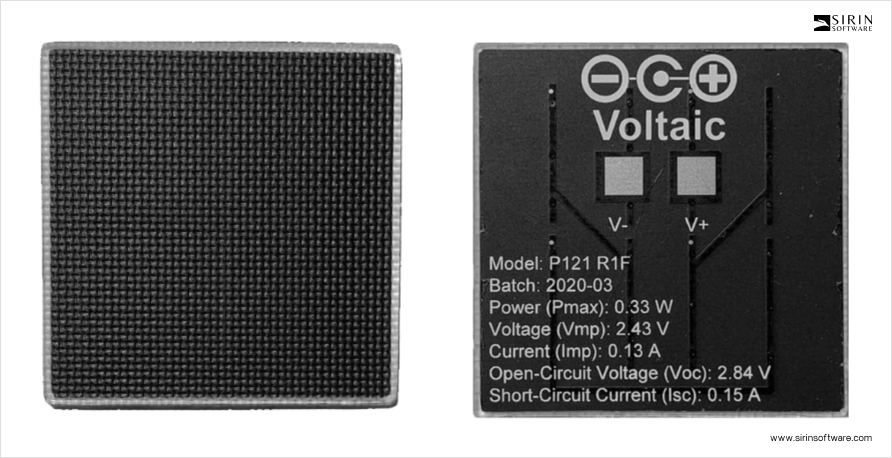
Voltaic PV Panels
We selected the Voltaic P121 R1L and P122 R1J PV panels for their specific characteristics adapted to various lighting conditions. The P121 R1L panel has a maximum power of 0.3 W, a voltage of 5.9 V, and a current of 60 mA, making it effective for outdoor use, especially in intense sunlight. The P122 R1J model, with a maximum power of 0.32 W and a voltage of 2.3 V, was declared to provide a current of 150 mA.
To enhance the functionality of Voltaic panels, especially in comparison with the Epishine module that already includes a supercapacitor, we also included the Voltaic C116 Lithium Ion Capacitor Charger in our selection.
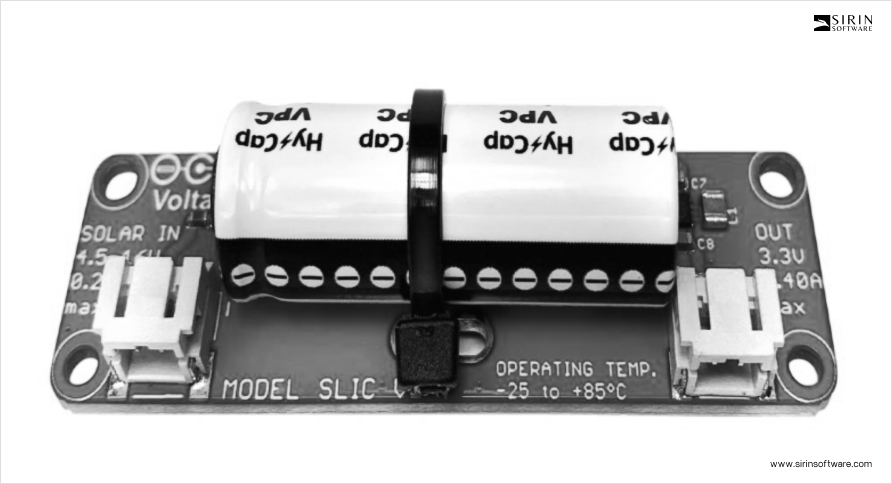
This device incorporates the Vinatech 250F VEL13353R8257G capacitor, providing an output from 2.5 to 3.8 V. It is equipped with a linear regulator and is designed for low-current consumption devices, making it suitable for working with Voltaic panels. This combination was chosen to create approximately equal experimental conditions for solutions from both vendors.
Development Kits
In our study, we examine the capabilities of photovoltaic panels using two distinct development kits: the Nordic NRF52832 and the Atmosic ATM3202. It’s important to note that these boards are not intended to be compared directly against each other. Each board has its unique processor and architecture, with inherent strengths and weaknesses. The NRF52832 DK, with its ARM Cortex-M4 processor, contrasts with the ATM3202’s advanced low-power design. Our goal is not to put these boards in competition but to evaluate the real possibilities and possible versatility of PV panels in powering diverse IoT devices.
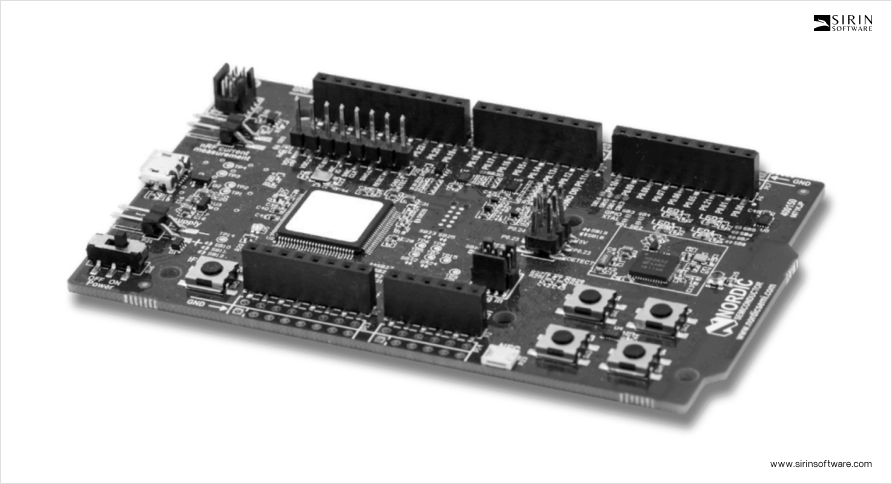
Nordic NRF52832 DK
We chose the Nordic NRF52832 DK development kit for our experiments for the following reasons:
- Energy Consumption: The NRF52832 DK is characterized by its low power consumption, making it ideal for IoT applications requiring extended autonomous operation. It consumes just a few microamperes in standby mode and up to 5.3 mA during active operation.
- Processor and Wireless Communication: With a 32-bit ARM Cortex-M4 processor and Bluetooth 5 support, it provides the necessary computational power and wireless communication for modern IoT devices, including automation systems, smart sensors, and more.
- Power Flexibility: The development kit supports a range of power supply voltages from 1.7 V to 3.6 V, allowing it to be used with various energy sources, such as solar panels and batteries.
These characteristics make the NRF52832 DK suitable for tour testing. Low power consumption, high computational power, and flexibility in power supply were key factors in our choice.
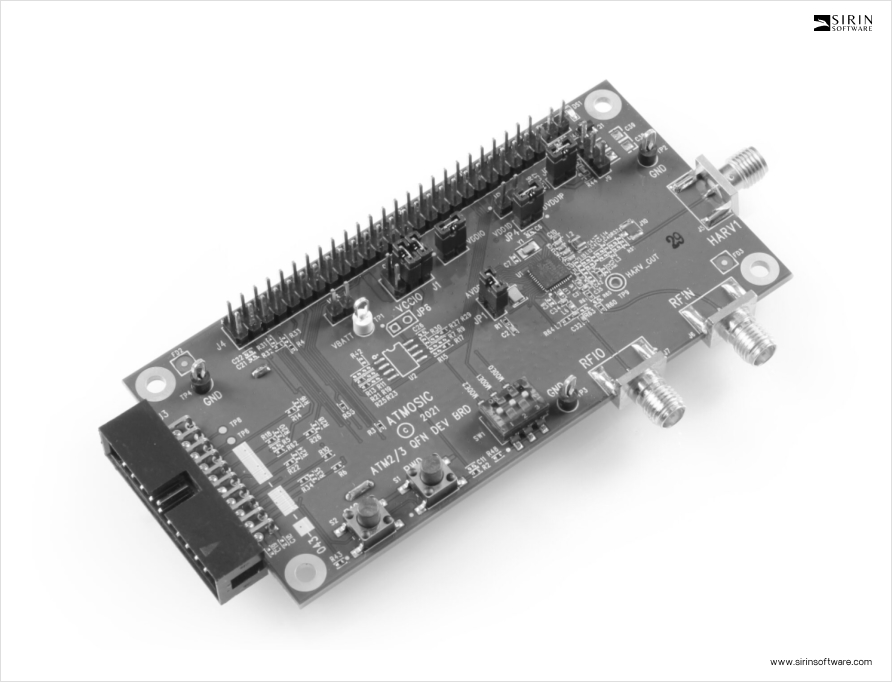
Atmosic ATM3202 Development Kit
The Atmosic ATM3202 Development Kit was selected for our experiments due to its:
- Energy Efficiency: The ATM3202 stands out for its ultra-low power consumption, a key attribute for IoT devices in energy-scarce environments. It operates on minimal power, utilizing just a few nanoamperes in sleep mode and around 3 mA in active mode.
- Advanced Processor and Connectivity: Equipped with a high-performance processor and supporting Bluetooth 5.0, the ATM3202 offers good computational capabilities and wireless connectivity, suitable for diverse IoT applications like health monitors and smart home devices.
- Power Versatility: This development kit supports a wide voltage range from 1.8 V to 3.3 V, compatible with various power sources, including solar panels.
These attributes make the ATM3202 an ideal candidate for our research. Its exceptional energy efficiency and adaptable power requirements align perfectly with the demands of modern IoT devices powered by solar energy.
Experiment Preparation: Simulating Real Conditions
- Outdoor Testing: We placed both the Voltaic panels and the Epishine module outdoors where they could receive the maximum amount of sunlight. We precisely measured the voltage and current generated by both devices under various lighting conditions.
- Indoor Testing: We also placed the Voltaic panels and the Epishine module in a controlled indoor environment with artificial lighting. Light meters maintained a consistent level of illumination, simulating indoor lighting conditions. We monitored the energy output of both devices under various lighting levels, providing data on panel performance in conditions close to real indoor usage.
Analysis of PV Panel Performance
Now, let’s delve deeper into the results we’ve obtained in a study of photovoltaic panels, assessing their efficiency under various lighting conditions for powering the NRF52832 and ATM3202 development kits.
NRF52832 Energy Consumption
This DK exhibits varying power consumption depending on its operational state, which plays a key role in evaluating its compatibility with photovoltaic panels and modules.
- Startup Current: During the experiment, an oscilloscope with a 10-ohm resistor in the circuit was used to measure the NRF52832’s startup current. The measurements showed that the voltage across the resistor was about 700 mV, corresponding to a startup current of approximately 70 mA. This is crucial as the startup current determines how well a PV panel can power up the device.
- Operating States: Like its counterparts, the NRF52832 has three main operating states – idle, advertising, and connecting. In idle mode, the device consumes only a few nanoamperes, making it exceptionally energy-efficient in this state. In advertising mode, consumption can vary from 1 to 10 mA, depending on the intensity and frequency of signal transmission. In the connecting state, current consumption depends on the specific application and can vary significantly. At this point, we were very hopeful that the capacitors we chose for the experiment would help ensure an uninterrupted power supply to the device.
- Real Scenarios: With all onboard LEDs of the NRF52832 turned on, the power consumption is about 13 mA. During startup, which lasts about 50 ms, current consumption increases to 70 mA. These data helped us understand the conditions that solar panels must meet to effectively power the device in its various operating modes.
ATM3202 Energy Consumption
For our study, the ATM3202 DK was programmed with two example applications: a BLE advertising and a hibernation mode. Initial tests showed distinct power usage patterns in both modes. Despite our focus on testing the previously described PV panels, the Atmosic ATM3202 Development Kit includes its own integrated energy harvesting module with a PV cell, which we also evaluated for completeness.
- Power Profiling: The ATM3202 DK’s power consumption was tested under BLE advertising and hibernation modes. Using a 220 Ω shunt resistor, we observed the voltage drop, so it was difficult to estimate power usage.
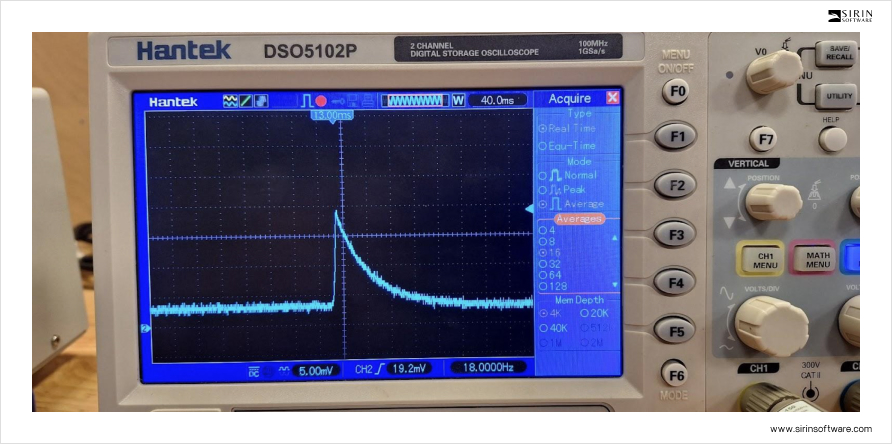
For a more detailed analysis, the Nordic Power Profiler Kit was used, showing that the peak consumption was around 1.3 mA during BLE advertising starts:
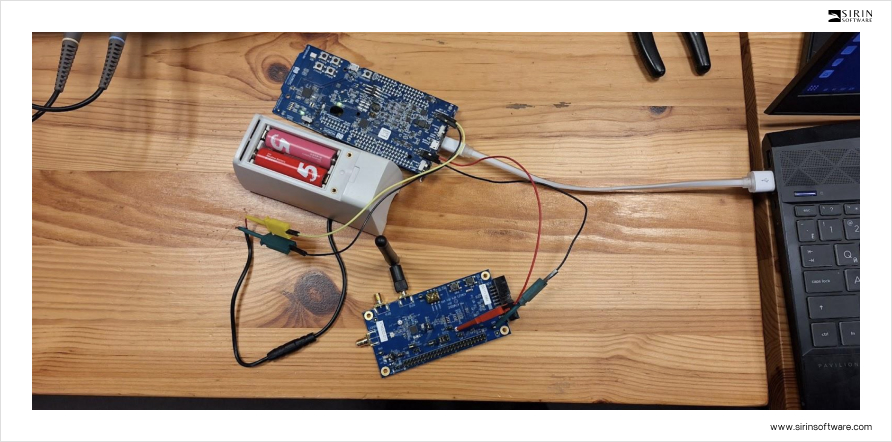
- Operating States and Server-Client Interactions: Further testing involved BLE server-client interactions, focusing on connection, notification, and disconnection phases.
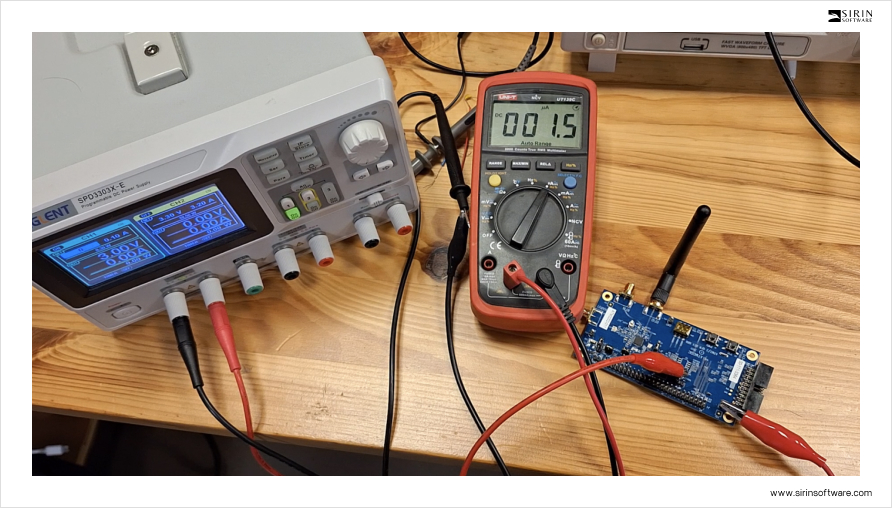
Our observations, backed by power profiling, showed that the device maintained low and efficient power usage across these states. For example, during BLE advertising, the average power consumption was around 18 μA, with a peak of about 70 μA, which seemed pretty impressive
- Real-World Application: The PV cell that comes along with the ATM3202 Evaluation & Development Kit and is tailored for indoor use, was capable of charging the onboard capacitor in about 10 seconds. The board started advertising within 30 seconds after the energy harvesting initiation.
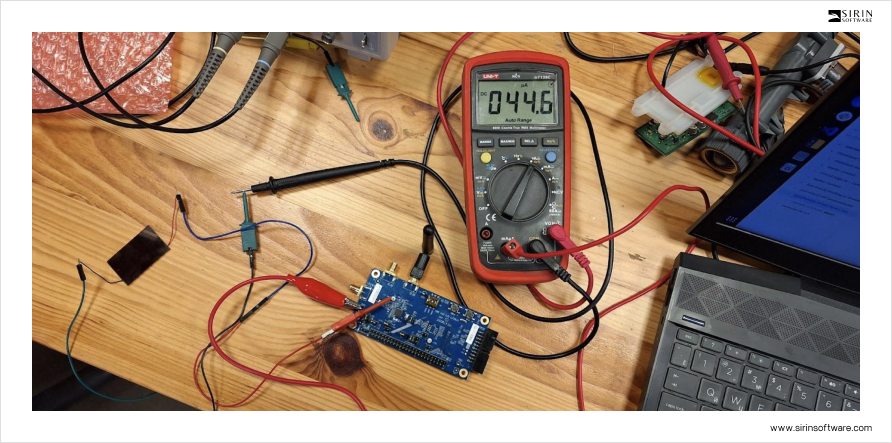
During our tests with the ATM3202 board, we noticed it sometimes lost its connection with the mobile app. This could be due to changes in the light indoors, which can affect how much power the board gets. Also, BLE technology can react to things around it, and the board’s software configuration might add to this issue. We found that when we increased the light inside, these problems went away. This suggests that for the ATM PV cell, the right amount of light is important for keeping the board connected.
Voltaic Panels Performance
- Voltaic P121 R1L: In outdoor experiments under sunny conditions, the P121 R1L panel, with a maximum power of 0.3 W and a voltage of 5.9 V, showed impressive results. It generated a current of approximately 120 mA, significantly exceeding the NRF52832’s startup current of 70 mA.
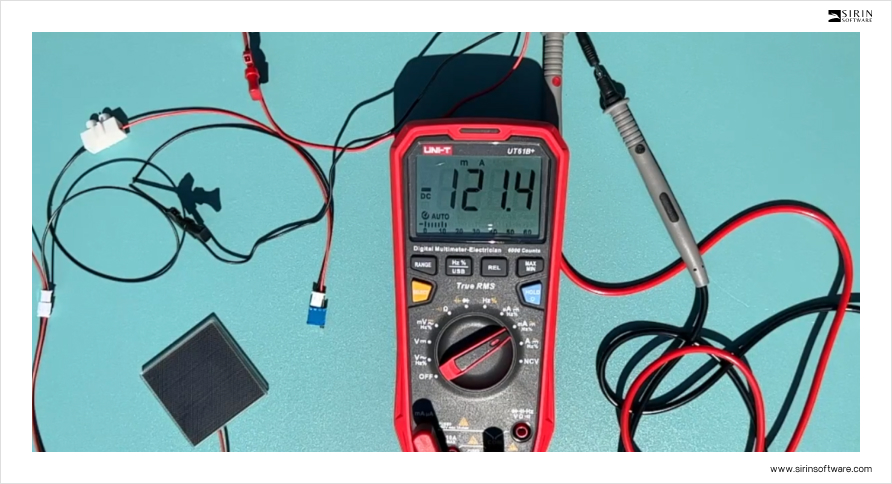
The panel also maintained a sufficient energy output level during indoor testing with artificial lighting.
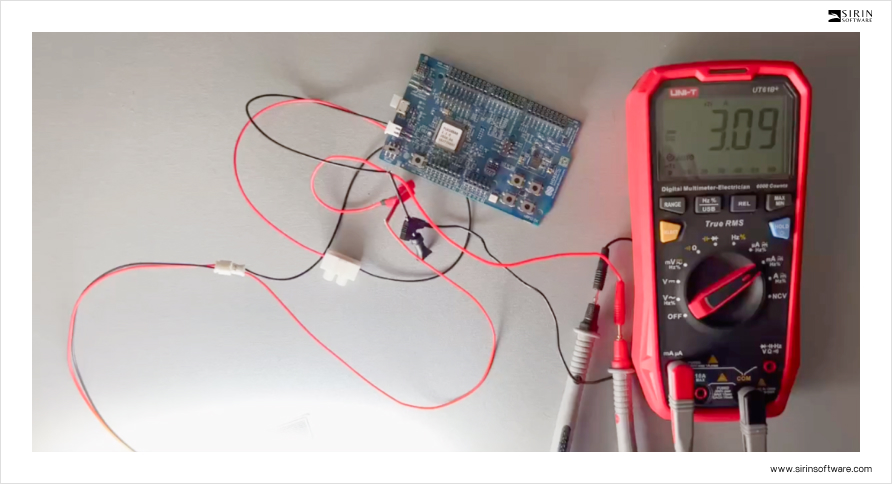
For the ATM3202 DK, the P121 R1L’s output of 120 mA in sunny conditions is more than adequate, considering the ATM3202’s lower startup current. The panel’s performance under artificial indoor lighting also effectively powers the ATM3202 in a variety of light conditions.
- Voltaic P122 R1J: Outdoors, with a maximum power of 0.32 W and a voltage of 2.3 V, the P122 R1J panel generated about 43 mA of current, insufficient to start the NRF52832.
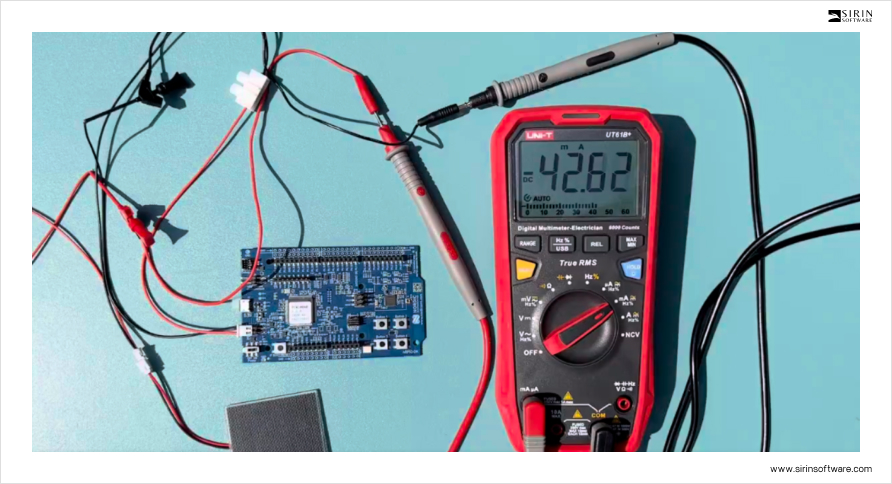
However, when used with the Voltaic C116 lithium-ion capacitor, the panel showed increased efficiency, with enough peak power to overcome the device’s startup and then continuous power to the NRF52832, even in non-ideal conditions.
Given the ATM3202’s lower power consumption, the P122 R1J’s output of 43 mA is sufficient for its operation, even more so with the aid of the C116 capacitor. This setup could provide a stable power source for the ATM3202, accommodating its energy requirements in different environmental conditions.
- Additional Information on the C116 Solar Charger
The Voltaic C116 capacitor, with a capacity of 250 F and a maximum operating voltage of 3.8 V, played a key role in the experiments. It stored energy up to 1805 J (approximately 0.5 watt-hours), enabling the NRF52832 to start up in unstable or insufficient sunlight conditions. With the P122’s maximum power output of 0.3 W, the capacitor could be fully charged in 100 minutes under clear weather.
With the ATM3202’s efficient power management, the energy stored in the C116 could allow for longer operation times or more reliable performance in varying light conditions, making it a suitable pairing for the ATM3202 as well.
Epishine Module Performance
A feature of the module is its ability to store electrical energy ranging from 1.9 Ws to 3.4 Ws depending on the output voltage, as confirmed in our study.
Even without a solar output, and considering the energy required for the NRF52832 startup (0.07 A x 3.3 V x 0.05 s = 0.01155 J), it was determined that approximately 1.88845 Ws of energy remained in the supercapacitor after startup (1.9 Ws – 0.01155 Ws). For the ATM3202 DK, considering its lower startup energy (0.05 A x 3.3 V x 0.05 s = 0.00825 J), approximately 1.89175 Ws would remain in the supercapacitor after startup (1.9 Ws – 0.00825 Ws).
With the NRF52832 consuming 0.0429 W (0.013 A x 3.3 V), its estimated operating time at 3.3 V was about 35 seconds (1.5015 Ws of energy) when the supercapacitor was fully charged again.
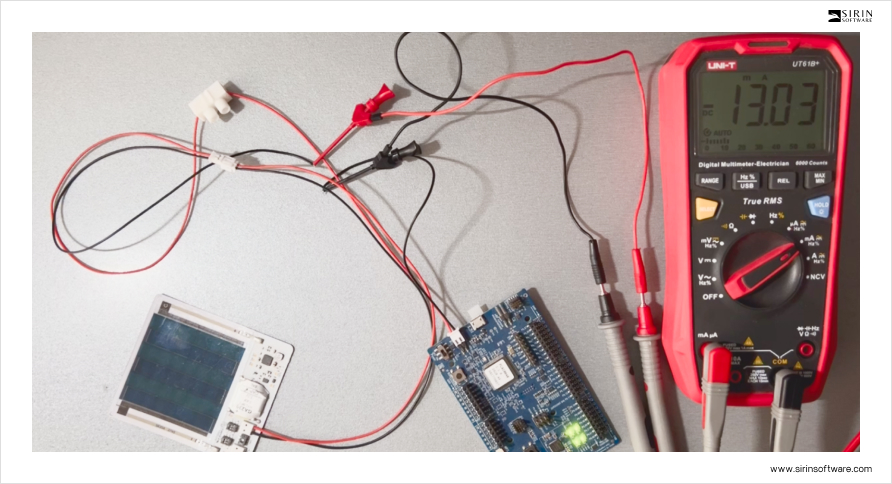
Additionally, we investigated the module’s performance at an output voltage of 1.8 V. In this setting, with the fully charged supercapacitor, the NRF52832 could operate for about 145 seconds under the peak load, and At 1.8 V, the ATM3202 could operate for around 574 seconds (about 9.5 minutes) under peak load, which is never needed in real usage cases.
It demonstrates the effectiveness of the Epishine module in various lighting conditions and, most importantly, confirms its ability to handle peak power demands during startup and connection of the IoT device based on the boards we chose for the experiment.
Conclusion: The Objective Evaluation
“In a market where being environmentally friendly is becoming more important, solar-powered connected products are a strategic chance to meet customer expectations and stand out in the tech world.”
© Øyvind Wetteland, Co-founder and CTO at Hyrex AS.
Our research shows that photovoltaic panels can be useful in certain IoT scenarios. In practical applications, compact solar panels show promise for a variety of IoT devices. For example, in smart agriculture, solar-powered sensors can monitor soil moisture and environmental conditions, leveraging sunlight available in open fields. In urban settings, solar energy can power smart parking sensors, which only require intermittent bursts of power. Additionally, in remote monitoring, such as wildlife tracking or forest fire detection, the minimal energy needs of these sensors align well with the capabilities of photovoltaic panels. Even in indoor scenarios, low-power devices like temperature or air quality sensors can function effectively in well-lit areas, utilizing indoor lighting. The key is to match the device’s power requirements with the expected energy harvest from the PV panels, considering factors like device sleep modes and energy-efficient communication protocols.
However, their current capabilities are limited by daylight time and may not always provide reliable and continuous power for a broader range of IoT devices, especially in less ideal environmental conditions. But with the proper setup of the device’s computing power algorithms, continuous operation solely on solar energy is feasible not only during daylight hours. Based on our study, we can draw important conclusions regarding the applicability of compact solar panels:
The efficiency of Voltaic Panels
The Voltaic P121 R1L panel demonstrated high efficiency in strong sunlight, but its ability to sustain stable operation of IoT devices in less ideal conditions remains questionable. This is especially true if we want to use more complex device modes, where the IoT board’s peripherals will be used more intensively, often with much higher power consumption.
The P122 R1J panel, while suitable for certain applications, has current limitations, particularly in less sunny weather, and may only be applicable in specific cases where the IoT device requires a combination of increased voltage with low current for rare and brief periods of peak activity.
Adaptability of the Epishine Module
This module proved efficient in low-light conditions, making it potentially suitable for indoor IoT applications. However, its ability to sustain long-term device operation without an additional power source is limited, especially considering variable indoor artificial lighting conditions. As with the Voltaic panels, uninterrupted power supply from a single module will primarily depend on the proper power consumption settings of the IoT device itself, to use its peripherals and performance capabilities only when truly necessary.
Note: The operational time for each PV panel and capacitor setup without solar input (e.g., nighttime) was calculated based on the following working mode:
- Advertising Mode: The device enters this mode once per hour for 5 seconds.
- Connecting State: Immediately following advertising, the device operates in this state for 10 seconds.
- Sleeping Mode: The device is in a low-power sleeping mode for the remainder of the hour.
These consumption rates were used to determine the total energy usage per hour, which was then compared against the energy storage capacities of the capacitors paired with each PV cell.
Role of Capacitors and Batteries
The use of supercapacitors and additional batteries as auxiliary power sources proved crucial for maintaining 24/7 IoT device operation where PV panels cannot provide sufficient power supply. We believe that PV panels with such onboard capacities, combined with wide options for adjusting output current and voltage, have the most potential for further development and market expansion in the context of integrating one module into one IoT device.
Sirin Software: The Future and Prospects
In a market where IoT demands increasingly complex computing capabilities at the individual device level, research seeking the necessary balance between computational power and energy consumption will never end.
Solar panel manufacturers daily offer newer, more advanced, and efficient solutions. Such advancements will open up more opportunities for using miniature solar panels in IoT devices, inevitably leading to the exploration of utilizing greater computing power at the device level. Therefore, we see the ability to correctly select, configure, and even create IoT devices as a key factor in this endless race.
A testament to our commitment to this field is our recent success story. In this project, we provided a client with an innovative solar-powered IoT device for environmental monitoring in urban areas. This device, capable of measuring air quality, noise pollution, and weather conditions, represents a significant stride in our efforts to marry high-efficiency IoT solutions with renewable energy sources.
At Sirin Software, we are constantly pushing the boundaries of what’s possible in IoT and renewable energy integration. Our goal is to develop IoT technologies that consume less energy while maintaining efficiency. This includes designing sensors and devices that work well with the energy provided by both current and future solar technologies. Our in-house expertise, from software development to innovative hardware solutions, uniquely positions us in this evolving landscape. We continue to strive for future research to contribute to the development of renewable energy use for integrating eco-friendly technologies into our daily lives.



